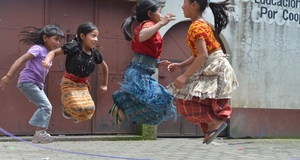Student VoicesResearch Shows Lack of Support for Transgender and Gender-Nonconforming Youth in U.S. School Systems
By
2010, Vol. 2 No. 01 | pg. 2/2 | « At least one advocacy group in addition to Pearson’s has found this to be true. The YES Institute is a Florida nonprofit which provides training on LGBT issues to school staff and other professionals. One school social worker who attended one of their sessions confessed that she felt “totally blindsided” by transgender children in their school: “My students need support now, and so far everything I know about this topic comes from daytime talk shows” (YES, “School”). The media is too biased and inaccurate to be relied upon for something so important, and yet many people’s only information about transgender issues comes from popular culture – if they know anything at all. Arlene Lev reports similar problems in the medical field. With few exceptions, she says, “the majority of clinicians, including social workers, counselors, psychologists, psychiatrists, and physicians, have not received training on the treatment of sex and gender identity or issues involving gender dysphoria and transgenderism (18).” This is especially disturbing considering that virtually all trans patients have to interact with multiple psychologists and physicians. When practitioners are as inexperienced as the general public, trans kids have yet another hurdle to overcome before receiving the services they deserve.This lack of even a basic understanding of lesbian, gay, bisexual and transgender identities is disheartening. As an advocate in a liberal and urban area, it is easy to forget that there are people who don’t even understand the idea of sexual orientation, or that gender and sex are different things6. Dr. Letha Maxton, Director of Student Services for Montgomery (Ala.) Public Schools, says it best: “This education is key to addressing the enormous fear in this community surrounding these topics” (YES, “Alabama”). If educators, healthcare providers, and parents had at least a rudimentary understanding of these issues, they would be able to create safe spaces for transgender children to live and learn, and many of the current problems would no longer exist. Until this happens, trans kids will continue to face incredible difficulties with not only school but their lives as a whole. Shortly after I spoke with her, Ms. Pearson drove two and a half hours from her home in rural Arizona to catch a last-minute flight to Kansas. The Kansas Department of Social and Rehabilitation Services removed a transgender child from their home, citing “emotional abuse,” and the parents were not prepared with the necessary knowledge and documentation to fight the department without help. This is just another example of authority figures lacking information about transgender children and harming them as a result. Such actions are unacceptable; something has to be done. ReferencesAnonymous male transgender youth, age 16. 23 Feb 2009. Online interview. Gainor, Kathy. “Including Transgender Issues in Lesbian, Gay and Bisexual Psychology.” Education, Research, and Practice in Lesbian, Gay, Bisexual, and Transgendered Psychology: A Resource Manual. Thousand Oaks, CA: Sage Publications, 1999. Google Books. Web. 23 Feb 2009. Greytak, Emily A., Elizabeth Diaz, and Joseph Kosciw. Harsh Realities: The experiences of transgender youth in our nation’s schools. New York: GLSEN, 2009. Web. 20 Mar 2009. Harris Interactive and GLSEN. From Teasing to Torment: School Climate in America, A Survey of Students and Teachers. New York: GLSEN, 2005. Web. 28 Nov 2008. Kosciw, Joseph G., Elizabeth Diaz, and Emily Greytak. 2007 National School Climate Survey: The experiences of lesbian, gay, bisexual and transgender youth in our nation’s schools. New York: GLSEN, 2008. Web. 26 Nov 2008. Lev, Arlene Istar. Transgender Emergence: Therapeutic Guidelines for Working with Gender-Variant People and Their Families. New York: Haworth, 2004. Print. Pearson, Kim. 23 Feb 2009. Online interview.7 Prosser, Jay. “No Place Like Home: The Transgendered Narrative of Leslie Feinberg's Stone Butch Blues.” Modern Fiction Studies 41.3-4 (1995) 483-514. Web. 23 Feb 2009. YES Institute. “Eye on Alabama.” ReVision 2009.1 2. Web. 13 Apr. 2009. YES Institute. “School Counselors Ask For Help.” ReVision Feb.-Mar. 2008: 4. Web. 13 Apr. 2009. Works ConsultedGrossman, Arnold H., and Anthony R. D’augelli. “Transgender Youth: Invisible and Vulnerable.” Journal of Homosexuality 51.1 (2006) 111-128. Informaworld. Web. 24 Feb 2009. The Harry Benjamin International Gender Dysphoria Association. Standards of Care for Gender Identity Disorders. 6th ed. 2001. World Professional Organization for Transgender Health. Web. 5 Mar 2009. Lombardi, Emilia L., et al. “Gender Violence: Transgender Experiences with Violence and Discrimination.” Journal of Homosexuality 42.1 (2001) 89-101. Web. 23 Mar 2009. Sparks, Richard L., and James Javorsky. “Section 504 and the Americans with Disabilities Act: Accommodating the Learning-Disabled Student in the Foreign Language Curriculum.” Association of Departments of Foreign Languages Bulletin 30.3 (1999) 36-44. Web. 23 Feb 2009. Endnotes2.) Kim Pearson and I met at the National Gay and Lesbian Task Force’s “Creating Change” conference in 2008. I donate time, money and services to her organization, and I am in a relationship with her son. 3.) “Sexual orientation” is one’s physical, emotional and sexual attraction to one or more genders. “Gender identity” is one’s inner sense of being male, female, some combination thereof, or something else entirely. 4.) Physical harassment is defined as behaviors like pushing and shoving; physical assault is being punched, kicked, or injured with a weapon (Kosciw xiii). 5.) cis- is the opposite of trans-; cisgender is the opposite of transgender. 6.) “Sex” is assigned based on one’s genitalia, hormones, chromosomes, and other biological factors – generally male, female, or intersex. “Gender” is one’s psychological identity – see “gender identity” above. 7.) This interview was conducted through instant messenger. For citation purposes, each message exchanged was numbered in the transcript. Suggested Reading from Inquiries Journal
Inquiries Journal provides undergraduate and graduate students around the world a platform for the wide dissemination of academic work over a range of core disciplines. Representing the work of students from hundreds of institutions around the globe, Inquiries Journal's large database of academic articles is completely free. Learn more | Blog | Submit Latest in Education |


















